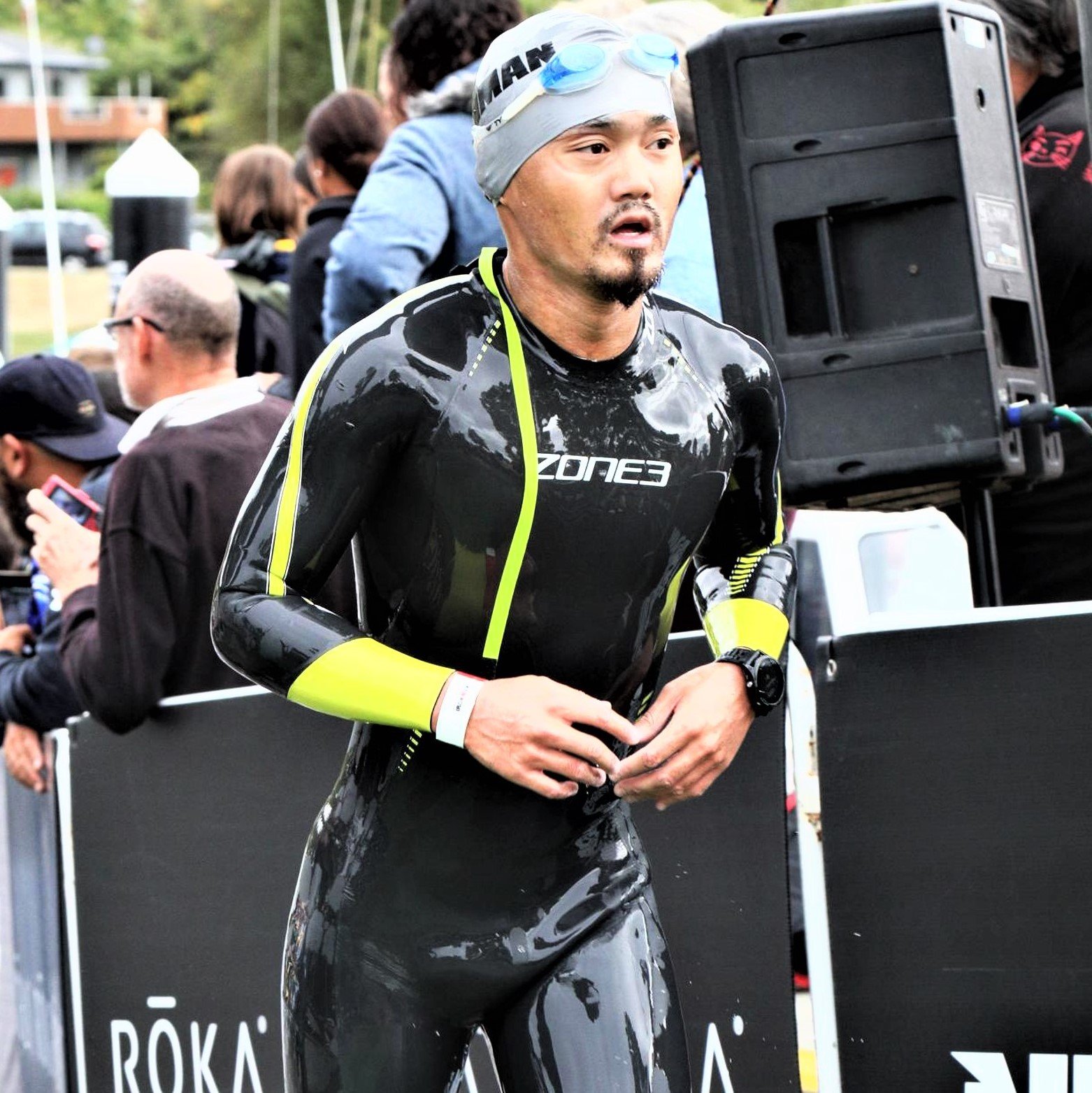So you signed up for the big 42.2. Congratulations. You’re about to embark on something 99% of people won’t even dare to think about.
If it sounds daunting, here’s the good news. The marathon is not impossible. We already know it’s not. Millions of people, of all ages, run the race every year. If you’re disciplined, if you prepare well, and if you really want it, you’re going to cross the finish line.
And we’re going to do it all following the keto diet.
Can you run a marathon on keto?
Most people think running a keto marathon is impossible, but in my experience it’s actually easier.
There are many reasons you might want to run a marathon on keto, but most of you will probably fall into one or more of the following:
- You’ve been following a keto diet and don’t want to stop because you feel great.
- You dislike eating a lot of carbs (possibly diabetic, insulin resistant, or sensitive to sugar highs and lows).
- You’ve read about fat-adapted endurance and it appeals to you.
- You’re afraid of bonking during the race.
- You’re on a carnivore/keto diet due to food allergies or sensitivities and want to know if endurance racing is possible on such a diet.
The good news is, it doesn’t matter which of these categories you fall into, because as long as you’re committed to finishing your marathon on keto, it can be done. I’m here to help you do exactly that!
What is the keto diet?
The keto diet is when you consume a very low amount of carbohydrates. This forces your body into a metabolic state known as ketosis, where your body starts to use fats as a fuel source instead.
Running a marathon on keto has the advantage of very sustained energy. Carbs get depleted from your muscles very quickly (within a few hours) but because fats are extremely abundant in the body (even very lean people have at least 30,000 calories of fats stored on their bodies) the keto diet provides you with an almost neverending source of energy.
As long as you pace correctly, this makes you almost bonk-proof. With the fat stores in your body, you can technically run several marathons back to back without running out ever having to eat a single calorie.
Who am I?
I’m not specifically a running coach, and I’m not a champion runner. I’ve run quite a few marathons though, and finished a full Ironman, and I’ve done it all following a low carb diet. So I know a little about what it takes to get across the line on race day.
The reason I’m writing this guide is because when I ran my first marathon and wanted to continue my keto diet, I couldn’t find a guide out there to help me do it.
So in this guide, let me show you how I trained for my first (and second and third) marathon. I ran a 4:37 in my first marathon, on 9 weeks of training. Pretty ordinary result, and I didn’t do anything spectacular or hire a coach or buy a special training plan. Just put my shoes on and run a little more each week. Kept my diet around a few specific foods. Plus a few other little things.
This guide will take you through all of it. Fun, simple, and all about the running. Let’s do it!
Training
If you search for marathon training plans on the web, there are lots of different types of runs you’re recommended to do in training.
Short run, long run, tempo run, repeats, sprints, zone 2 runs, zone 3 runs – it just went on and on. By the time I’d finished reading a training plan, I already felt like giving up.
Here’s the thing, your first marathon doesn’t need to be that complicated. It doesn’t need to be complicated at all.
Sure, if you follow some special plan you might run a 4:20 instead of a 4:35. But if you’re constantly checking your heart rate and your pace and trying to run in some different way every time instead of just running and enjoying it, is it even worth it? Is it even fun?
So I say, forget all that.
We’re going to break it down into two types of runs. Just two.
Short runs and long runs.
Difference between a short run and a long run
The names are self explanatory, but let’s put a number on them.
A short run is anything under 10km.
A long run is anything over 10km.
When you’re first starting your training, your short runs might only be 1 or 2 km. Near the last quarter of your training camp, your short runs might all be 9km. Your first long run will likely be 10km, and you’ll eventually get up to around 30km.
Heart rate? Doesn’t matter. Pace? Doesn’t matter.
Just get the kilometres in.
Your Marathon Training plan
When training for your first low carb marathon, the goal is to condition your body to be able to run 42.2km.
If you get half way into your training and feel really good and think you can aim for a good time, you can think about that when the time comes. But at the beginning the goal is to survive the distance.
How do we achieve this goal?
We need to run a lot. Here are some assumptions we’re going to make to undertake this training plan:
- You can already run 5km without stopping.
- We have 16 weeks to train
- You have time to train 4-5 days per week max.
Here’s what your training plan will include:
- Short runs (1km to 9km)
- Long runs (10km to 30km)
- Strength training
- Cross training such as bike or swim (optional)
- Mobilization and injury prevention
- Sleep
- Nutrition
- Race Day strategy
Short runs
Ideally you want to do 2-3 short runs per week.
Start small and build it up to the 10km mark.
How small to start?
Put your shoes on and go for a run outside. Run at an easy pace – slow enough that you can have a conversation with yourself.
You can even talk to yourself every few minutes while you’re running to make sure.
Hey, how you feeling. I’m feeling good. Good weather today right? Yeah, totally.
Sure, you might feel like a oddbod, but it’s all part of your training. Being conversational while running is actually a very popular litmus test to make sure you’re running at the right pace to build up your base fitness.
What is base fitness?
Your base fitness is your anaerobic fitness. It’s the level of energy output that’s low enough for you to run off fats instead of glucose. If you want to run a marathon on keto, you want to be constantly developing your anaerobic fitness. Technically, you should be able to run at your anaerobic pace for several hours without taking in any calories – that’s the power of keto running! So be sure to constantly keep your pace in check so your base fitness is constantly improving.
In your first week of training, start with 1km runs. Aim to do three in your first week.
For example, you could run 1km on Monday, Wednesday and Saturday. That’s a solid first week of training.
When you decide to increase the distance, start by only increasing your final run of the week, rather than all three.
For example, your second week could be 1km on Monday, 1km on Wednesday, and 2km on Saturday.
Your third week could be 1km on Monday, 1km on Wednesday, and 3km on Saturday.
As long as you’re increasing the distance of one of your runs each week, you are building endurance in your legs and progressing towards be able to start doing long runs.
Here’s a sample training plan for your first 6 weeks:
Long runs
Long runs are runs over 10km.
If you’re starting from the level of a 5k runner, you won’t be doing any long runs in the first 4 weeks.
Running 10km is actually quite a feat – it’s just shy of a quarter marathon and most of the population cannot do it. You will need to build up to this fitness level through consistent short runs over your first weeks of training.
When you can comfortably run 4-6km multiple times per week, you will be ready to attempt your first long run.
Remember, when you first start doing long runs, it’s okay to take breaks. For example, you can run 5km, take a water break, then run the next 5km.
If you’re running at your anaerobic (conversational) pace, you shouldn’t feel tired or out of breath, as your pace should be slow and you should running off ketones. Your obstacle will most likely be your legs.
What are ketones?
Ketones are the fuel your body uses when it is running on body fats. In the absence of carbohydrates, your body no longer will have a source of glycogen from carbohydrates and instead will turn to ketone production to provide energy to your body.
If your legs aren’t conditioned to run that distance, you might start getting niggles in your calves, knees, thighs or feet. This is why you start with short runs and slowly build the strength up in your legs to handle the 10km distance.
As a first time marathoner, you should aim to do no more than two long runs per week. Because your body is unaccustomed to running this kind of mileage, your biggest risk of not finishing the race is not actually the 42.2km on race day, but the risk of an injury in training. We’ll talk more about this further down.
The “Long Run” Day
It’s a good idea to designate one day of the week as your long run day.
Most people like to do this on Saturday or Sunday as they have the whole day free.
Your long run day might start at 10km, but as you get closer to race day, you’re likely to be running up to 30km on your long run day. It’s an important part of training and will condition your body and mind to last the distance on race day. A marathon is a long race, and if your body isn’t prepared for long distances you risk shutting down in those final kilometres.
Here’s a sample training plan for your final 10 weeks of training. You do not need to follow it to the letter, but it gives you a good idea of the mileage you need to build the strength in your legs to last the marathon distance:
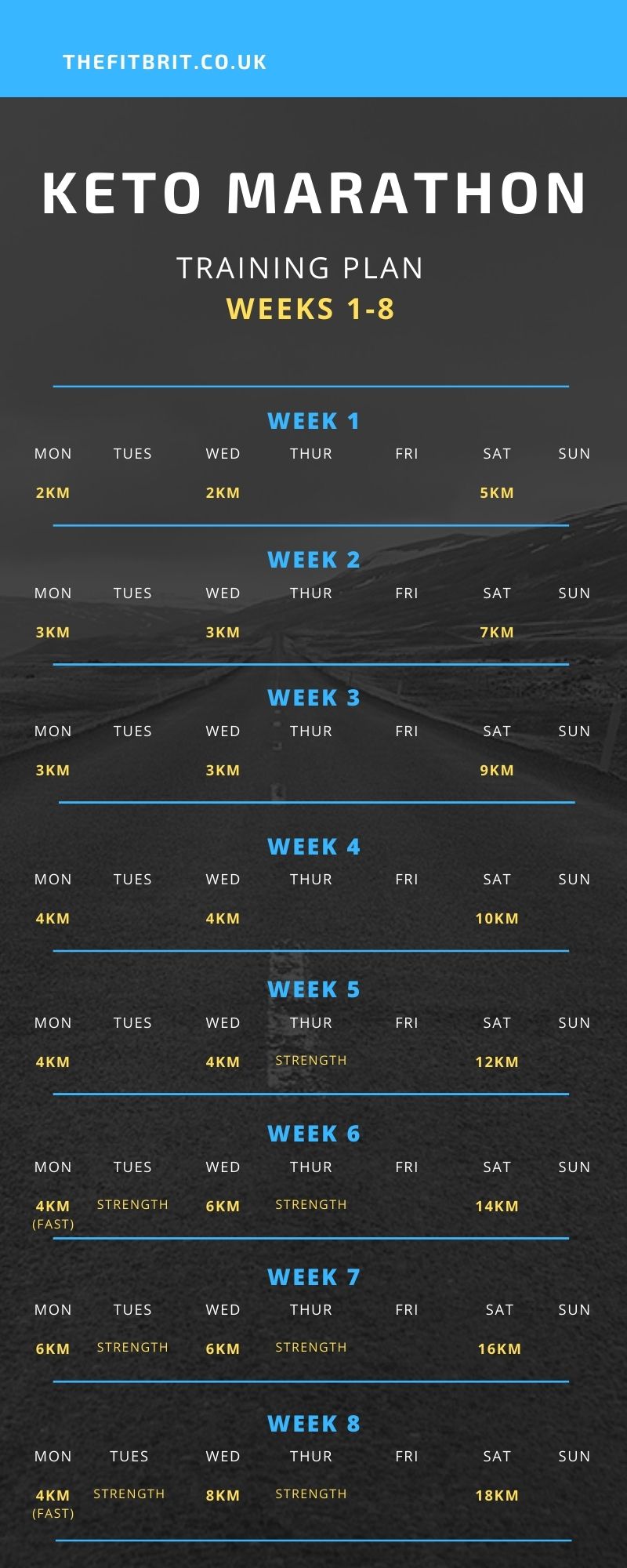
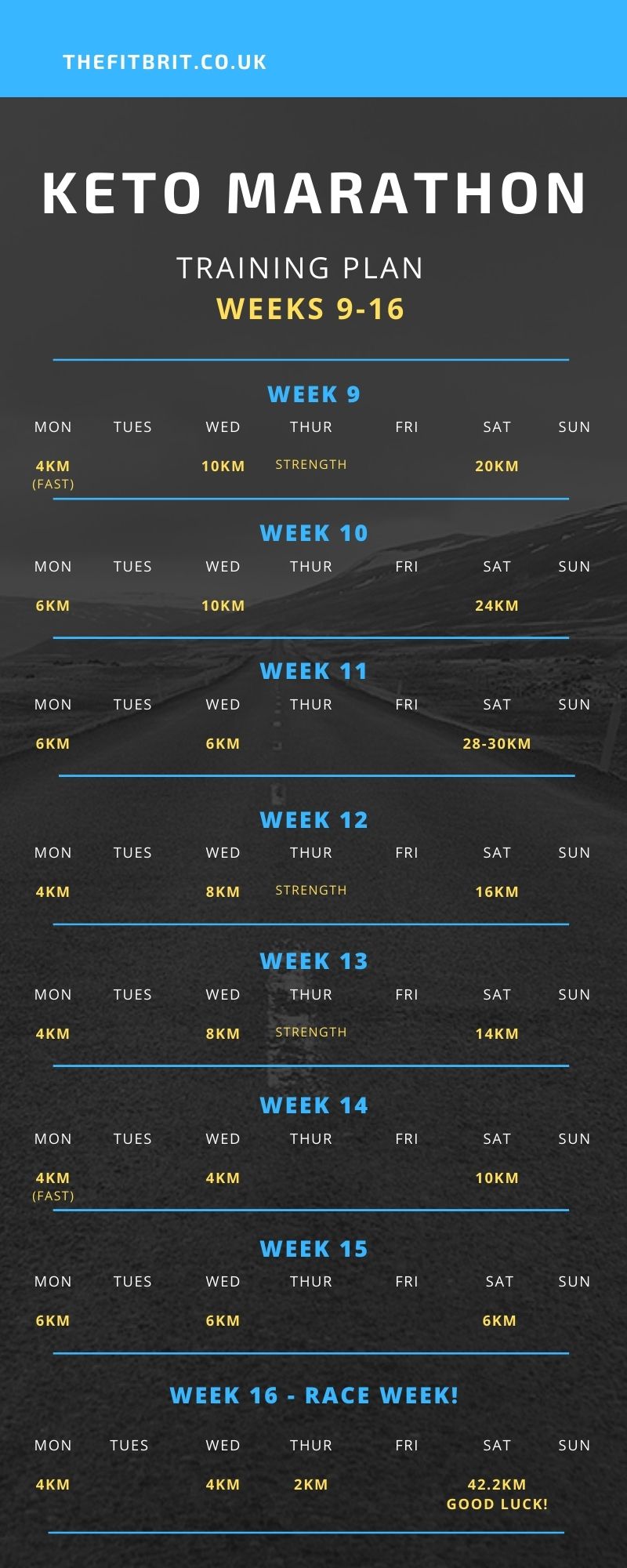
Note: “Fast” simply means to run faster than your anaerobic pace. If you are struggling to talk/speak in full sentences, that level of effort is considered “fast”.
Strength training
One thing that’s very beneficial to add into training is strength sessions. You will see “Strength” sessions are scattered throughout the training plan above.
Even if you only do this once a week, it will make a big difference to how your body holds up on race day.
A strength session can be as simple as some core exercises and some bodyweight. You do not need a fancy gym membership.
Ironman Dave Scott recommends these 5 strength exercises for an endurance athlete:
- Stretch cord row
- Fly
- Hip Extension
- Romanian Deadlift
- Squat Curl Press
All of them focus on the core, with some secondary focus on the legs. You can get a full explanation of the exercises here.
As an experiment, next time you go running place your palms on your belly and notice how much your abdominals tense and grind during your run. They are the muscles that connect the top and bottom of your body and work extremely hard during running. Investing some time in making them as strong as possible will help you a lot over those final kilometres.
Cross training
This part of your training is entirely optional.
If you feel like your legs have been taking a beating and need a rest, you can substitute one of your runs with a swim or a bike session.
Swim sessions are fantastic for burning a ton of calories and giving your legs a rest.
Bike sessions are great for rainy days, and for reducing impact on your knees and feet. If you’re suffering from a knee injury like IT band syndrome or a foot injury like plantar fasciitis, it’s possible you can still get your training in on a spin cycle without experiencing any pain or aggravating your injury.
Keep these options in mind when things start to get tough in the middle of your training season.
Stretching and Mobilisation
The number one risk of not completing your marathon goal is injury.
A very large percentage of first time marathoners do not even make it to the start line. They do not give their body proper care during training and a busted knee or foot stops them from even completing the first kilometre.
If you don’t want this to be you, make sure you read this section carefully.
Every time you train, you need to maintain.
What does maintenance involve?
It involves stretching out your muscles so they can heal and recover properly. It also involves moving and massaging your joints so they do not tighten up and restrict your movement and flexibility.
Almost all injuries are the result of athletes not investing enough time in maintenance.
I highly recommend reading a book called Ready To Run, which covers all major running injuries and the stretches required to prevent/treat them. It has served me very well and I think it will you as well.
However, to get you started here are a collection of my favourite mobilisations that you can get started with. In the training plan above, mobilisations have not been included specifically, because you should be doing them every day by default!
Do at least one or two of these daily.
For hips, ankles and quads:
For knees/IT bands:
For feet/plantar fasciitis:
Glutes/hamstrings:
Hips:
Sleep
Your body recovers when you sleep.
This makes sleep a mandatory and often overlooked part of a successful training plan.
However, anything less than 7-8 hours a night is going to be detrimental to your training and greatly increase your risk of injury.
Many athletes say long distance racing is not a sport, it’s a lifestyle. This is because it requires you to embrace the sport in every aspect of your life – this can mean having early nights on the weekends so your body can recover from grueling long runs. Giving up a glass of wine or beer at lunchtime to keep your diet on track. Skipping Friday night drinks at work to get to bed early for your long run the next day.
Remember to always prioritise sleep during training. Your success on race day is highly influenced by the amount of rest you give your body.
Nutrition
Let’s get into what foods you should be eating during your training.
A keto marathon is going to have a very different nutrition plan from the regular marathon training plans you see floating around out there.
While most plans say you need upwards of 500g of carbs per day, we will rarely be eating more than 50g.
All the foods that marathoners love to gorge on, such as rice, pasta, potatoes and bread, we will be eating none of. Our plates will be mostly proteins, green vegetables and lots of healthy fats.
We will also be doing most of our training sessions fasted to stimulate ketone production and ensure we’re highly fat adapted athletes on race day – making us bonk free, fat burning machines.
Ideally you want to be eating in the range of 70% fats, 25% proteins and 5% carbs, but in my experience it is not essential to stick to these ratios to achieve ketosis. As long as your carb count is around that 5% mark, your protein and fats ratio is flexible and varies from person to person.
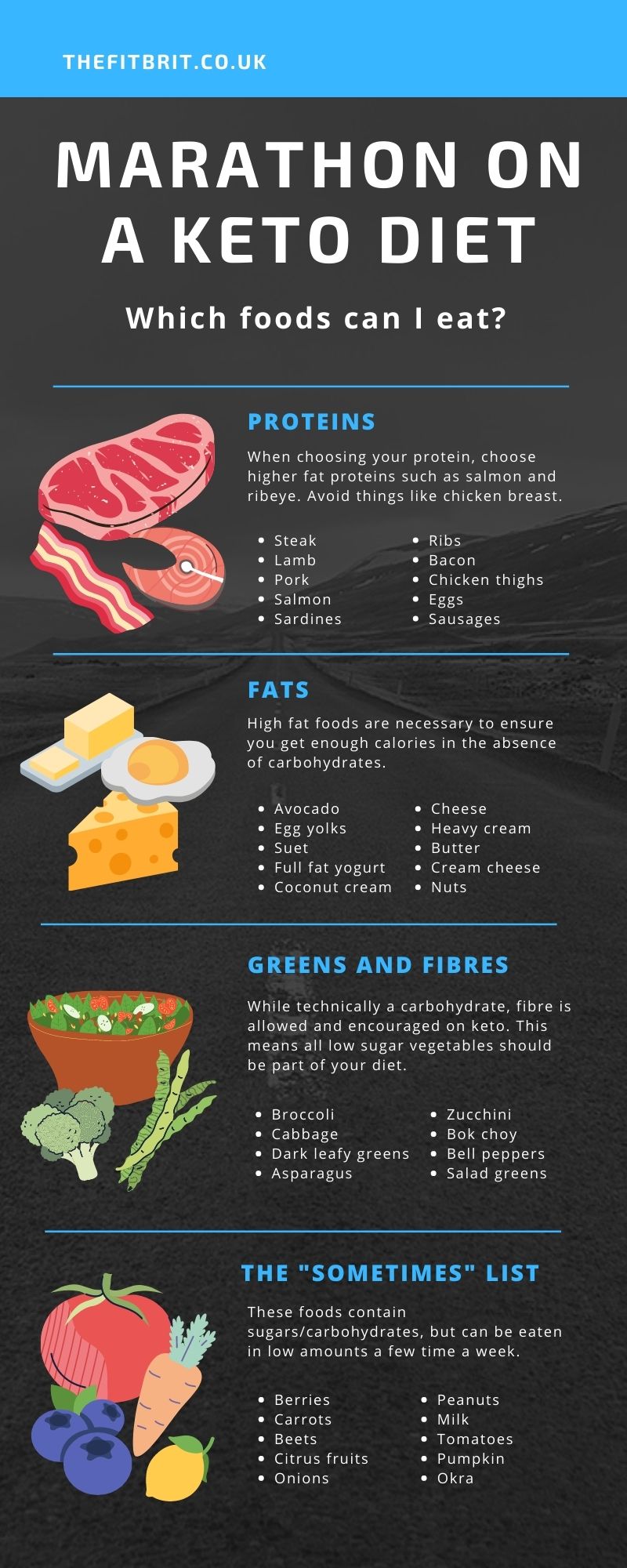
You’ll notice the things missing from this list are:
- Breads
- Pasta
- Rice
- Cereal
- Potatoes
- Sweet potatoes
- Bananas
- Watermelon
- Apples
- Pineapple
- Most other fruits
- Alcohol
- Candy
- Most sauces
- Most starches
The reason is most of these items contain carbohydrates or sugars (or both) and eaten in any substantial amount will jeopardise your body’s progress to becoming fat adapted. The infographic above is not the be-all end-all of the foods you’re allowed, but I would suggest sticking to that list as you transition into the diet.
Here’s some ideas for your first keto grocery list. You can also check out our list of favourite keto snack foods to help get you through those tough days.
How many calories?
Because fats are abundant in the body, there is no target amount of calories you need to eat each day. When racing on carbs, many athletes will say things like “I need to get at least 400g of carbs today” but you do not have a minimum or maximum amount of food to eat when you’re a keto athlete.
Instead, simply eat the right foods, and eat until you’re full, aiming for 70% fats, 25% proteins and 5% carbs.
Also, as long as you are training on an empty stomach, your carb allowance also has some flexibility provided you eat them soon after training.
If you want to be certain your body is reaching ketosis, you can test your ketone levels with a simple ketone test. We recommend this one.
What to eat before training?
This might sound odd, but my recommendation is to not eat anything before training.
In fact, during low carb marathon training I usually have my first meal in the late afternoon, around 4pm or 5pm.
Even on days when I’m doing long runs, I’ll knock out 25km or more on an empty stomach.
This is part of the magic of keto. Even if you haven’t eaten, your gas tank is never empty because you will always have stores of body fat you can use. Forcing your body to use these stores, especially during long runs, will train your body to be fat adapted at a very high efficiency.
Once you have finished your training, you can start your feeding for the day to replenish some calories and give your body the nutrients it needs to recover for tomorrow’s session.
What about water?
Of course, you can drink as much water as you please at any time of the day. Water has no effect on ketosis and it’s important to stay hydrated just like any other athlete.
One peculiarity with the keto diet is your body tends to dump salts into your sweat and urine in much larger amounts. Therefore it is recommended that you supplement your water intake with electrolytes to avoid dehydration and cramping.
Of course you will need a low carb electrolyte supplement. I highly recommend Ultima Replenisher. It has zero carbohydrates and all essential electrolytes in abundance.
Race day
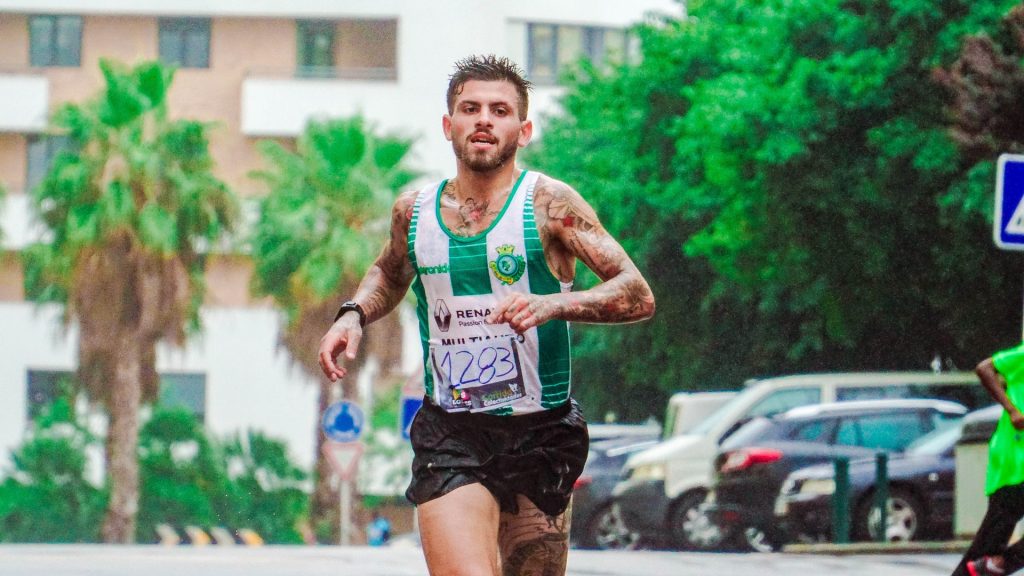
The big day.
Everybody has their own routines for race morning but there are a few bits of advice I will leave you with that I think will be helpful.
Nothing new
The biggest piece of advice I will give here is don’t try anything you haven’t tried in training!
If you train for every long run on an empty stomach, then start the race on an empty stomach too. If you drink a coffee before every training, the drink a coffee before the race too.
If there is something you want to do during the race, such as utilise some sugars or gels for a boost, then make sure you trial this in training too.
You should not be doing anything for the first time on race day!
Salt pills
These are extremely important to prevent you from cramping. As a keto athlete you will be dumping a lot of salts during the 42.2km and you need to replenish these.
I recommend using Saltstick. Keep them in your race belt or your pocket and eat one every 20-30 minutes.
No products found.
Train low race high?
This is popular for many keto runners, which involves doing all your training on strict keto, but then using carbs on race day to give you a boost.
Because the marathon is such a large distance it is very unlikely your carb intake during the race will disrupt your fat burn. Most people find it actually gives them a huge boost because they now have two working fuel tanks – your usual ketone production, and the sudden intake of carbohydrates which will go straight into your bloodstream.
I have tried it personally and it’s quite effective.
Some people even go as far as to carbo-load a few days before the race to pack their muscles with glycogen, but I find this doesn’t work for me. However, if I start the race on an empty stomach and then take in carbs during the race, it gives me a very noticeable energy boost.
If you want to do something like this, it is recommended you trial it first during one of your long runs.
The carbs you take in during race day can be anything from gels to gummies to the drinks the race provides at the aid stations. Check some examples out here:
It’s up to you to test them during training and see which ones you like!
Good luck!
That’s everything I can possibly share with you on running your first marathon on keto. Now that you have the “how”, all you need to focus on is the work.
Choose your race, get your shoes on and start training!
Last update on 2024-04-08 / Affiliate links / Images from Amazon Product Advertising API



